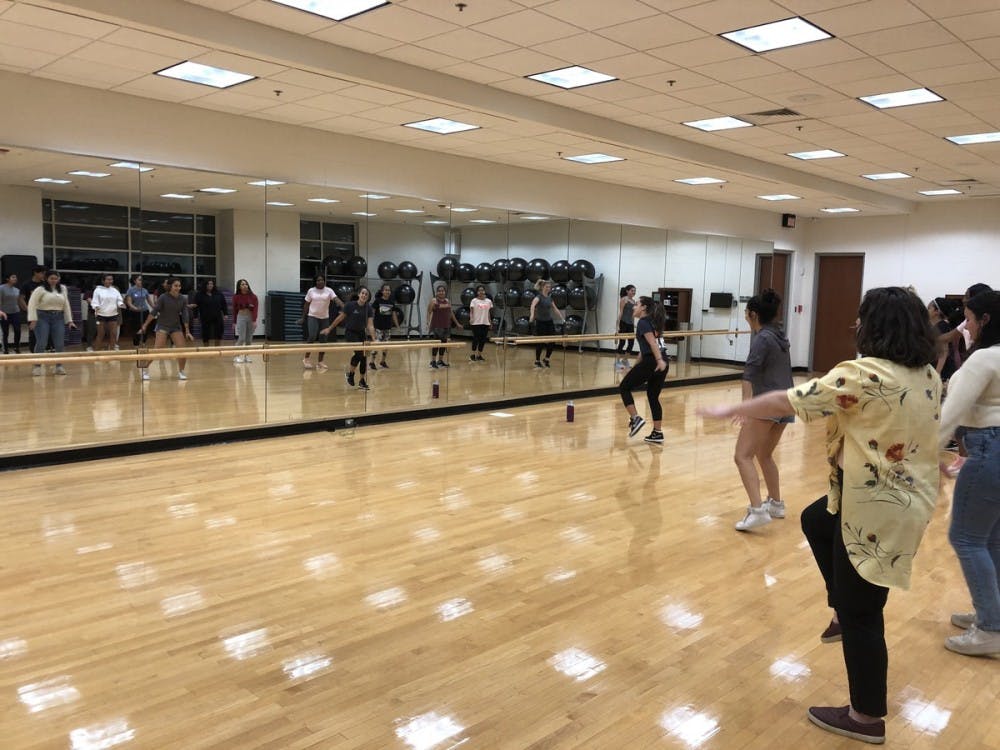Amidst the madness of midterm woes and mid-semester projects, students joined together to celebrate Latinx culture at “Bailemos! La Vida es Una Fiesta” — an event put on by the Latinx Student Association and sponsored by the Salsa Club and the International Residential College. “Bailemos” translates to “Let’s dance,” and “La vida es una fiesta” means “Life is a party” in English.
The event was held Friday night in a multi-purpose room in the lower floor of the AFC. Programming included Zumba — which is a type of high-energy dance exercise — and a free salsa class taught by members of Salsa Club. Roughly 22 students attended the event. While LSA funded the event through its budget, Salsa Club also provided free salsa instruction and the IRC provided smoothies to attendees.
Micaela Vilanova, second-year College student and cultural chair for the LSA, and her committee worked to plan Bailemos! and publicized the event through the LSA and through the MSC newsletter. All students and faculty at the University were welcome to attend. The event was intended to be a joyful time in which students could appreciate Latinx music and dance.
“So for Hispanic Heritage Month, we already [had] several events focusing on different areas,” Vilanova said. “We already had an art gallery celebrating Latinx art, and this time around we want to celebrate the music. We feel it’s a really important part of the Latinx community, so mainly it is to celebrate and to have fun with a special part of our culture that we love and listen to every day.”
At first, many attendees hung toward the back as Zumba instructor and third-year College student Sonja Kapadia began to teach the class. Kapadia played a variety of music that eventually got everyone in the room moving.
“The thing I love about Zumba is that its a very multicultural activity,” Kapadia said. “It was started by a Colombian … so initially a lot of the music was in Spanish, and now it’s just kind of evolved. I have Bollywood songs, I have French songs, I have English songs and obviously a lot of Spanish music, which is so much fun to dance to. I think it brings a lot of people together even though it’s just an exercise class, but it’s a flair that exposes you to really fun music.”
After students warmed up during the Zumba class, two instructors from Salsa Club taught a couple of basic steps. Attendees were encouraged to switch partners throughout the night, so they had a chance to build community with new friends as they learned salsa dancing.
While the steps may not have been perfect, attendees shared laughter and joked over missteps. After working up a sweat dancing, attendees hung around and socialized over free smoothies.
Second-year Nursing student Alyssa Gail Valencia and her roommate, second-year College student Diana Guzman Lugo, attended the event because they were excited about the opportunity to dance to Spanish-language music.
“I love Spanish music, so I loved the music, and I also liked the environment ... it’s not too small where other people scrutinize you,” Valencia said.
Bailemos! was one of many events the LSA held on Grounds in order to commemorate National Hispanic Heritage Month, which lasts from Sept. 15 to Oct. 15. This is a time to honor the contributions of Latinx members as well as to celebrate and preserve Latinx culture. Other events that the LSA held included a Latinx Game night, a soccer tournament and Una Plática — a discussion about Central American identities held over a meal of pupusas, which are similar to a thick flatbread — with Central Americans for Empowerment at U.Va.
National Hispanic Heritage Month is historically significant, as its starting date of Sept. 15 is also the anniversary of the independence of several Latin American countries, including Guatemala, El Salvador, Honduras, Nicaragua and Costa Rica. Additionally, the anniversary of the independence of Mexico and Chile fall within the month — Sept. 16 and Sept. 18, respectively. The national celebration began in 1968 under the Lyndon B. Johnson administration as National Hispanic Heritage Week but was expanded in 1988 to encompass an entire month.
According to students, the importance of National Hispanic Heritage Month lies at a deeper level than the history books. It also carries great significance as a tool to raise awareness about Hispanic culture.
“I think now, Hispanic culture goes through a lot of hate, or like bad attention, especially through the media, but there’s so much more,” Lugo said. “I don’t want that … attention to overshadow our culture and our history because there’s a lot of history that I love. I know that each country [is] very different, and we have our own stories to tell.”







